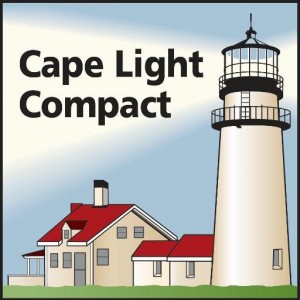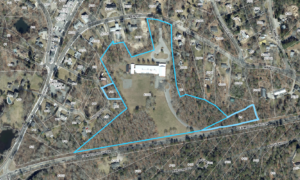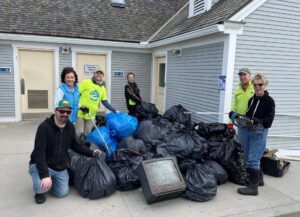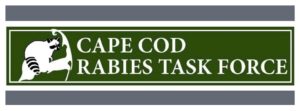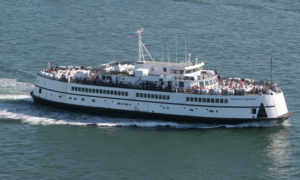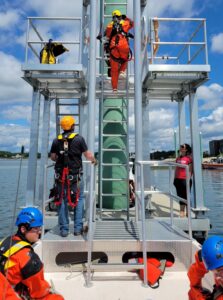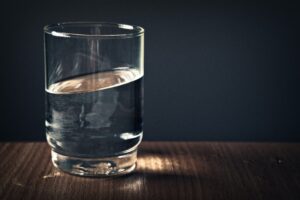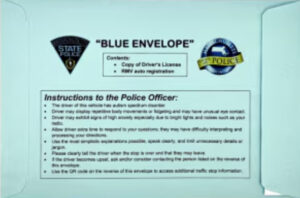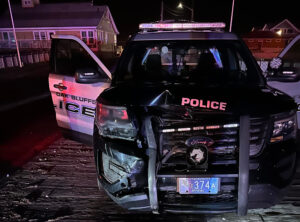
CCB MEDIA PHOTO
Rachel Jakuba, science director for the Buzzards Bay Coalition, explains the testing that goes on at the Marine Biological Laboratory as part of the Baywatchers program. Dr. Chris Neil, director of the MBL’s Ecosystems Center, stands at right.
WOODS HOLE – Water testing in Buzzards Bay is taking place one month earlier this summer.
Marine Biological Laboratory Ecosystems Center Director Dr. Chris Neil said this is the first time the water testing program, which is done as part of a large monitoring and science program the lab does in collaboration with the Buzzards Bay Coalition, has begun in June.
Last Monday as State Secretary Matthew Beaton of the Department of Energy and Environmental Affairs toured the facility with state representatives David Vieira and Tim Madden as well as State Senator Vinny deMacedo, samples were being received and tested as part of the MBL’s collaboration with the Coalition.
Neil, who brought the state officials on a tour of the lab, said the earlier start time for the testing is due to the effects of climate change on the bay. The water warms up in June to the temperatures that used to come to the bay in July, he said.
The testing program to measure the health of Buzzards Bay has been underway since 1992.
The testing through the Baywatchers program relies on 100 volunteers and is the largest coastal monitoring program in New England, according to the coalition.
“A couple times per month, volunteers fan out across all of the harbors of Buzzards Bay, across more than 30 estuaries in Buzzards Bay and two to four spots within estuaries up and down the riverine, near the mouth, up in the fresh water ends,” Neil said.
Each week, the volunteers measure the following parameters: dissolved oxygen, temperature, salinity, water clarity.
The samples then come into the lab in Woods Hole where they are filtered.

CCB MEDIA PHOTO
A lab at the Marine Biological Laboratory in Woods Hole is the place where testing takes place for samples taken as part of the Baywatchers program. Samples are taken from 200 spots in Buzzards Bay by volunteers working with the Buzzards Bay Coalition.
“We run them for nutrients, chlorophyll, which is a measure of phytoplankton biomass. The goal really is to track the quality of water. The big issue for Buzzards Bay is nitrogen loading from the watersheds,” Neil said.
The scientists are analyzing the water samples for nitrogen, phosphorus and algal pigments, according to the coalition.
The program also uses federal guidelines. According to the coalition, all data collection and analysis is conducted in accordance with a Quality Assurance Project Plan approved by the US Environmental Protection Agency and the Massachusetts Department of Environmental Protection.
Neil said the program is a critical one for the region.
“We’re looking at how things have changed over time in dozens of estuaries, in multiple places within estuaries. It’s one of the strongest science-based records of coastal water quality change that exists in the United States and it exists as a partnership between a scientific organization, MBL, and a citizens-based advocacy but a very science-based advocacy organization,” Neil said.
Rachel Jakuba, science director of the Buzzards Bay Coalition, explained the origins of the program.
“The whole reason we started the program is there wasn’t really anyone tracking the health of Buzzards Bay. If you want to make decisions about how to deal with the environment, you need baseline data to show what is changing, what the problems are. So that is why the coalition got involved, as we did,” Jakuba said.
The coalition through its volunteers collects data from over 200 stations.
“We’ve been working with scientific academic institutions to make sure we have very rigorous data collection,” she said.
Jakuba explained that the data is used in a variety of ways by federal, state and local governments.
“Our data has been used to classify waters as to whether they are impaired or healthy, which is important to determine whether a water body needs a nitrogen limit for that water body. It’s also been used in the issuance of permits for groundwater discharge and even by towns in trying to decide how to deal with local regulations. Towns use the data to see where the problem spots are in their local area,” she said.
A line item in the current senate budget contains funding for the program, Jakuba said. The program also receives funding from the Buzzards Bay National Estuary Program from federal Environmental Protection Agency.
But the vast majority of the funding for the program comes through donations from the 8,000 members of the coalition who live in the watershed, Jakuba said.




